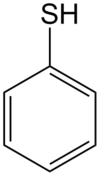Benzenethiol
|
|
|||
| Names | |||
|---|---|---|---|
|
Preferred IUPAC name
Benzenethiol
|
|||
| Other names
Thiophenol
Phenyl mercaptan Mercaptobenzene |
|||
| Identifiers | |||
|
3D model (JSmol)
|
|||
| ChEBI | |||
| ChEMBL | |||
| ChemSpider | |||
| ECHA InfoCard | 100.003.306 | ||
|
PubChem CID
|
|||
| RTECS number | DC0525000 | ||
| UNII | |||
|
|||
|
|||
| Properties | |||
| C6H6S | |||
| Molar mass | 110.17 g·mol−1 | ||
| Appearance | Colorless liquid | ||
| Odor | Unpleasant, pungeant | ||
| Density | 1.0766 g/mL | ||
| Melting point | −15 °C (5 °F; 258 K) | ||
| Boiling point | 169 °C (336 °F; 442 K) | ||
| 0.08% | |||
| Solubility | Most organic solvents; aqueous base | ||
| Vapor pressure | 1 mmHg (18°C) | ||
| Acidity (pKa) | 6.62 (H2O), 10 (DMSO) | ||
| -70.8·10−6 cm3/mol | |||
| Hazards | |||
| Main hazards | Toxic | ||
| R-phrases (outdated) | R10 R24/25 R26 R41 | ||
| S-phrases (outdated) | S23 S26 S28 S36/37/39 S45 | ||
| Flash point | 56 °C; 132 °F; 329 K | ||
| US health exposure limits (NIOSH): | |||
|
PEL (Permissible)
|
none | ||
|
REL (Recommended)
|
C 0.1 ppm (0.5 mg/m3) [15-minute] | ||
|
IDLH (Immediate danger)
|
N.D. | ||
| Related compounds | |||
|
Related thiols
|
1,2-Benzenedithiol Benzenemethanethiol |
||
|
Related compounds
|
Phenol Benzeneselenol Diphenyl disulfide |
||
|
Except where otherwise noted, data are given for materials in their standard state (at 25 °C [77 °F], 100 kPa).
|
|||
|
|
|||
| Infobox references | |||
Thiophenol is an organosulfur compound with the formula C6H5SH, sometimes abbreviated as PhSH. This foul-smelling colorless liquid is the simplest aromatic thiol. The chemical structures of thiophenol and its derivatives are analogous to phenols except the oxygen atom in the hydroxyl group (-OH) bonded to the aromatic ring is replaced by a sulfur atom. The prefix thio- implies a sulfur-containing compound and when used before a root word name for a compound which would normally contain an oxygen atom, in the case of 'thiol' that the alcohol oxygen atom is replaced by a sulfur atom.
Thiophenols also describes a class of compounds formally derived from thiophenol itself. All have a sulfhydryl group (-SH) covalently bonded to an aromatic ring. The organosulfur ligand in the medicine thiomersal is a thiophenol.
There are several methods of synthesis for thiophenol and related compounds, although thiophenol itself is usually purchased for laboratory operations. Methods are the reduction of benzenesulfonyl chloride with zinc. and the action of elemental sulfur on phenyl magnesium halide or phenyllithium followed by acidification.
Via the Newman–Kwart rearrangement, phenols (1) can be converted to the thiophenols (5) by conversion to the O-aryl dialkylthiocarbamates (3), followed by heating to give the isomeric S-aryl derivative (4).
In the Leuckart thiophenol reaction, the starting material is an aniline through the diazonium salt (ArN2X) and the xanthate (ArS(C=S)OR). Alternatively, sodium sulfide and triazene can react in organic solutions and yield thiophenols.
...
Wikipedia


